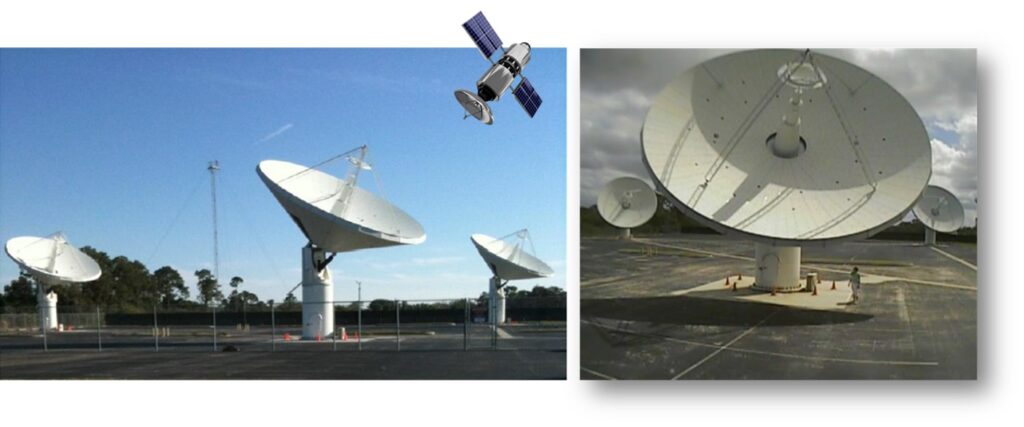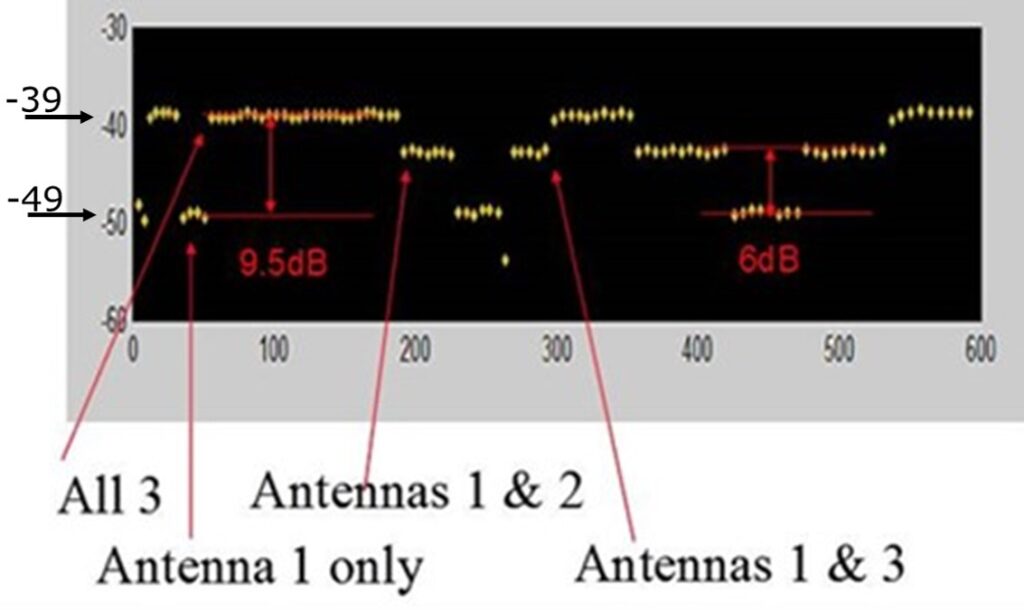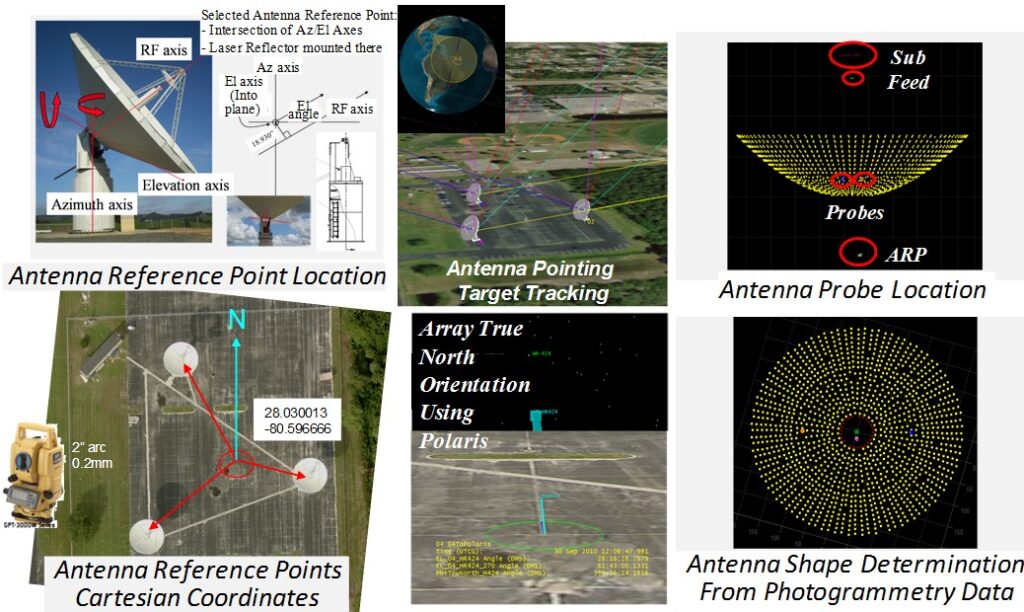Deep Space COMM
Martin & Minear Method: Large reflector arraying technology
Our Self-Controlled open loop, large reflector transmit and receive arraying technology is already at a Technical Readiness Level 7, TRL-7. It remained coherent for the entire six months of operation. Unlike expensive, state-of-the-art antennas like the Deep Space Network, DSN, COTs antennas and hardware can be used. The equipment and fiber don’t require temperature control since it’s internally self-calibrating. Unlike all other methods, feedback from external sources, such as from a satellite, tower or the Moon is not needed. With our method, the antennas are always optimally phased at the target.
DESCRIPTION

Arraying is the adaptive combining of widely-spaced antennas for simultaneous coherent transmission and reception of signals. It overcomes the size and power limitations of a single reflector system. The power instead can be dispersed among the antennas. A widely-spaced array of COTS (Commercial Off-The-Shelf) large ground reflectors outperforms even the largest traditional phased array and is easily expandable for greater power and longer ranges.
Human missions to Mars have been contemplated since the 1950’s. Human exploration and colonization of Mars is now a goal of national space programs. Communication to spacecrafts, landers and rovers requires high EIRP and has been traditionally handled by VERY large custom ground antennas. Our arraying technology can change all that, while reducing cost and increasing mission reliability.
The Deep Space Network (DSN) 3-70m antennas are located in Goldstone, Madrid and Canberra. The locations are roughly 120 degrees apart for global Space coverage. They were built in the 1960’s and extended in size from 64m to 70m in 1989 to support the Voyager spacecraft Neptune encounter.
While the DSN has smaller antennas, such as several 34m reflectors at each worldwide site, they cannot match the 70m’s EIRP. A failure of any one of them jeopardizes mission security and requires reallocation of mission assets and mission replanning. This is what happened in 2006 when the Madrid 70m antenna failed due to damage to two of the four huge bearings that carry its weight as it turns. It happened again from May 2019 and September 2020 to the Goldstone site due to klystron issues.
As a response to the Madrid failure, Specialized Arrays’ principals proposed and successfully demonstrated, in 2010, an alternative to a single large antenna; an array of smaller COTS antennas. The program was funded by NASA. It was entirely successful, bringing the technology to a TRL-6.
According to NASA HQ, it was the only operationally feasible arraying solution since it was instantly available on power-up and didn’t require constantly pointing away for re-calibration using external sources (e.g. the moon, towers, or satellites) as the others did. NASA HQ Exceptional Engineering Achievement Medals were awarded to the principals, Martin and Minear and JSC Group Achievement Awards presented to the team.
In order to coherently combine signals leaving antennas that are widely spaced, three sources of phase error need to be addressed.
- The time -of-flight from each antenna to the target
- The different signal paths including circuitry, electronics, and fiber
- Tropospheric effects, particularly at low elevations and higher frequencies
The method we chose for Deep Space Comm was open-loop (vs closed loop, requiring feedback) since feedback from Mars would not arrive in time to be useful. A detailed description and the demonstration results can be found here.
From 2011 till 2020, we continued developing our open-loop method and extended it to radar systems, where the receive and transmit arrays are not co-located.
INNOVATIONS
- Robust, reliable, widely-spaced coherent transmit and calibrated receive arraying
- 24/7 availability, instantly available on power-up
- Autonomous, continual self-calibration without the need for towers or satellites
- Tolerance for COTS hardware and relaxed circuit stability requirements
- Applicability to a wide range of antenna and array sizes
- Mitigation of antenna reference point errors using known astrometric sources
- Real-time sensing and correction of tropospheric propagation variation using passive emissions
EXAMPLE
With control of Space moving from NASA to commercial companies, communications to and from Space assets will follow. The DSN is aging and the use of single antennas to reach further into space is no longer innovative. A robust array of smaller COTs antennas that are instantly available at power-up is the future.
From 2008-2010, on a NASA contract, we developed and demonstrated large reflector widely-spaced coherent transmit and receive arraying to a GEO satellite. We used 3-12m reflectors and demonstrated the N2 EIRP increase where N is the number of antennas, that is, 10 LOG10 (32) = 9.5dB EIRP increase. Another way to look at it is that the array provides 6dB EIRP increase every time the number of antennas, N, is doubled. Ten antennas would provide 100 times the radiated power.


After surveying the antennas (shown above), the system remained calibrated for the entire 6 months of operation, until the end of the program when it was powered down.
Unlike all other experiments to date, this method does not require periodic re-calibration in order to remain coherent (synchronized with respect to timing or phase using external objects such as satellites). A system that relies on periodic re-calibration is not available 24/7 but a bigger drawback is that between calibration events, the state is unknown. This can put important missions at risk.
Our demonstration of open-loop coherent transmit and calibrated receive arraying with continual, autonomous local calibration of ALL electronics and fiber proved the feasibility of this technology for operational missions that require 24/7 availability.
Alternate methods using external calibration targets (satellites) and manual adjustments were attempted by various groups at KSC (KaBOOM and KARNAC) between 2012 and 2018. These were not successful. The array calibration drifted in between attempts; coherency could not be maintained.
BENEFITS
- 24/7 availability due to the inherent redundancy of the array elements
- Instantly ready on power-up
- Expandable for higher EIRP or greater distances by adding antennas to the array
- Low risk: core technology has been successfully demonstrated (TRL-6)
- Is autonomously and continually coherent (both Tx and Rx arrays)
- Doesn’t require periodic recalibration
- Doesn’t require use of external objects for calibration
- Enables scheduled maintenance of individual antennas without system shut-down
- Dispersed near-field radiation avoids personnel radiation hazard
- Enables precision electronic beam control which reduces wear and tear on antennas
- Larger field-of-view due to wider beam of smaller antennas
- Higher directivity due to narrow beamwidth of the array
